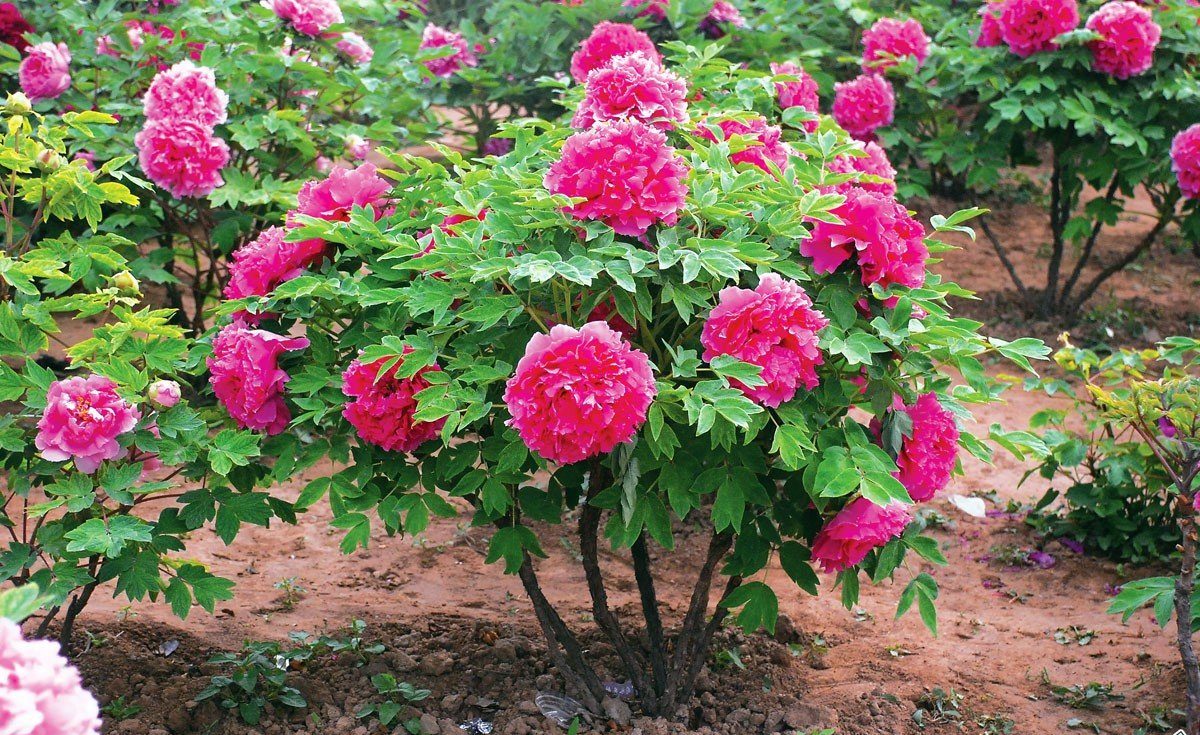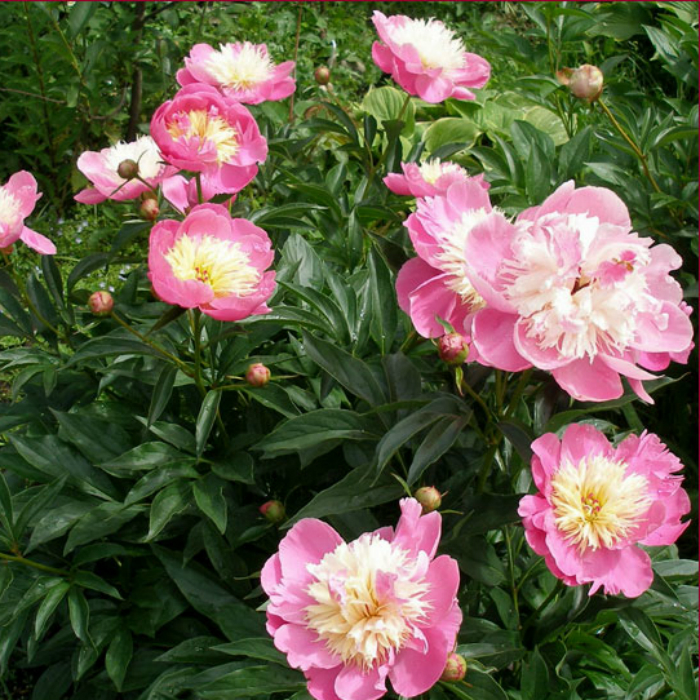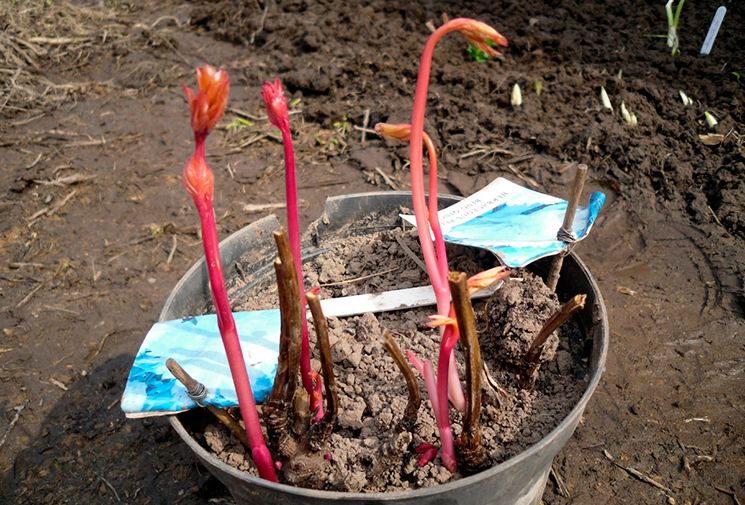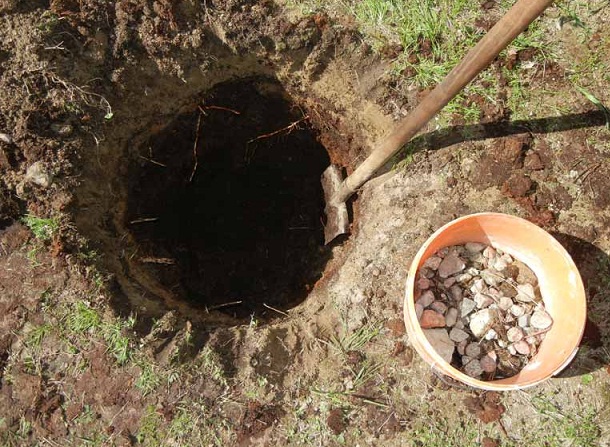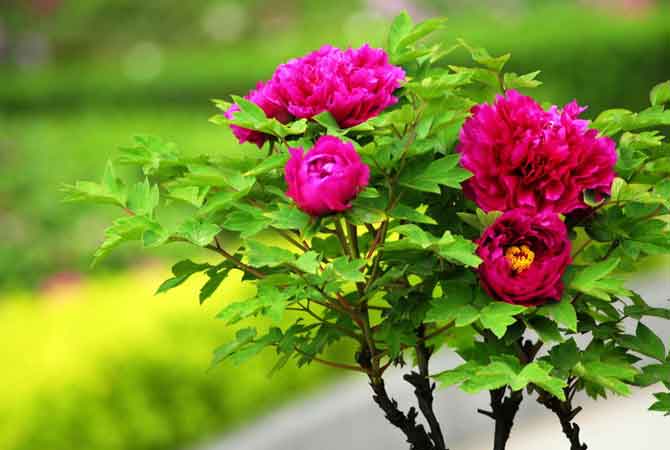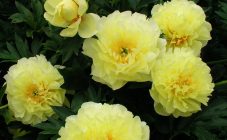Content:
Tree peony, or semi-shrub peony is a tall deciduous shrub of the Peony family, originally from China. It was introduced to Europe at the end of the 18th century. At the same time, the English botanist D. Banks compiled the first description of a flower for botanical reference books. Today this plant is found in every garden and has its own planting characteristics.
Description of the tree peony
The height of a tree peony is 150-200 cm. Externally, a bush peony is a large, branched shrub of a hemispherical shape, which is achieved due to the fact that the peony stems do not fade with the onset of autumn, but, on the contrary, grow more and more every year. Strong, erect, pale brown stems topped with single multi-petal buds of various shades. Depending on the variety, peony petals can be yellow (Golden Scatter), purple (Transparent Dew), pink (Red Giant), white (White Jade) and even bicolor (Kiao Sisters). In addition, the buds can have a gradient color, in which one color smoothly passes into another. How the most popular peonies look like can be seen in the photo.
The texture of the petals also differs depending on the variety. There are hybrids with double, semi-double and smooth petals. The diameter of the buds reaches 14-22 cm.
The peony blooms profusely. The number of flowers on one bush varies from 35 to 50 pieces. Flowering lasts 2-3 weeks.
The foliage of the tree peony is openwork, feathery.
What is the difference between a tree peony and a herbaceous one
First of all, a tree-like peony can be distinguished from a herbaceous one by its stems. In the herbaceous variety, the shoots are soft, while in the tree peony they are tough, strong. This is due to the fact that in the fall the shrub sheds foliage, but not branches, which are only getting stronger every year. In a herbaceous peony, shoots die off every year.
Another difference is frost resistance. Varieties from China cannot boast of this quality, however, hybrids were bred in the botanical garden of Moscow State University, which can be grown not only in temperate climates, but also in the Urals and Siberia, which cannot be said about its herbaceous counterpart. At the first frost, its flowers quickly turn black.
The varieties also differ in ripening time. The herbaceous peony in the first years of life annually adds foliage in volume, but the flowering itself begins only at 3 years. The tree peony practically does not grow for the first 8-12 months. It may even seem that at some point the growth of the bush has stopped. The first flowers on the bush appear only when the plant reaches a mark of 50-60 cm.This usually happens 5 years after the peony is planted.
In general, these two varieties bloom at different times. The herbaceous peony blooms 2 weeks later.
Finally, unlike the woody peony, the herbaceous cultivar must be pruned regularly. Cutting the buds stimulates subsequent flowering and helps to distribute the plant's vitality more efficiently.
Reproduction
Bush peony is propagated in different ways: freshly harvested seeds, cuttings, grafts and layering.
In the first case, a flowering bush is needed to collect seeds. The bushes are propagated by layering in May before flowering. Peonies propagate by cuttings starting in mid-July. One of the best ways to breed peonies is grafting. It is held in mid-August.
Selection of seedlings
When choosing seedlings, the type of root system of the flower is important. It can be open or closed. Seedlings sold in a container have a closed root system. If the roots are bare or in a bag of substrate, then this is an open-rooted plant.
It is equally important to determine whether the seedling is grafted or has its own root system. The grafted have dark and thick roots, somewhat reminiscent in appearance of carrots or perennial parsley root. Such plants bloom already in the first year of life, however, it is not so easy to acquire seedlings of this type. They can only be purchased from their respective nurseries.
Saplings obtained from layering have weak, long, whitish roots. Peonies with such a root system bloom only at the 4th year of life.
Tree peony: planting and care in the open field
The planting time of the tree peony depends on the type of root system of the seedling. Plants with closed roots can be planted almost any time of the year, but it is best to do so during the spring months. So the peony can bloom in the same season.
Seedlings with an open root system are usually planted in late August - early September. When planting in spring, there is a high risk that the plant will not be able to take root, since its roots will not keep pace with the rapid development of green mass.
When choosing a place to plant a tree peony, it is better to give preference to a well-lit area. Prolonged exposure to the shade has a detrimental effect on the development of the plant.
The most suitable soil type for woody peony is loam.
How to plant a tree peony:
- The soil for planting must be prepared in advance, since it must settle. Planting holes are dug at least 2 weeks in advance.
- The shape of the planting hole should resemble a cone with a diameter of 50-70 cm. The optimum depth is 50-60 cm. The minimum distance between two adjacent holes is 1-1.5 m. The distance to the nearest large plants is at least 2 m, to trees - 3 m.
- Drainage is poured at the bottom of the planting pit: broken brick, sand, gravel or expanded clay. The drainage layer should be at least 10 cm thick, but larger is better.
- Rotted manure is laid on top of the drainage, which is then covered with fertile soil. It includes peat, bone meal, top layer of earth and humus. In this case, a small mound should turn out.
- When planting a seedling with a closed root system, it is enough to transfer it with a clod of earth and sprinkle it with the remains of fertile soil so as to fill the planting hole. A seedling with an open root system is placed directly on the formed tubercle of soil mixture, while distributing the plant roots over its soil surface.
- Water the peonies immediately after planting. About 5 liters of water are poured under each seedling. After watering, a seedling with an open root system is sprinkled with earth so that the root collar is at ground level.
- The soil is lightly tamped and mulched with peat or humus.
How to care for a tree peony
Growing and caring for a tree peony does not present any particular difficulties. Basically, it comes down to periodic loosening of the soil, cleaning weeds and feeding plants. Sometimes it may be necessary to form a support for the bush.
Watering
Peonies are watered abundantly, but not often, since these plants do not cope well with high soil moisture. One watering every 1-2 weeks will be enough, while on average from 6 to 8 liters of water should go to each bush. It is also important to consider the amount of precipitation.During dry periods, water the plants more often.
Starting in August, the amount of water during irrigation is gradually reduced to a minimum. This is done so that the wood has time to mature before the onset of frost.
Fertilizers
The tree peony needs regular nitrogen and potassium supplements. Abundant fertilization is especially necessary during periods of intensive growth. With the onset of flowering, phosphorus fertilizers need to be introduced. At the same time, it is important to remember that an excess of fertilizer is also harmful to peonies, as is their lack. Excessive nitrogen content in the soil can provoke the appearance of gray rot.
In addition, the abundance of dressings often entails burns of the root system of the bush. To avoid this, it is recommended to water the fertilizers with water just before feeding the plant itself.
Winter protection
Despite the fact that the tree peony is highly frost-resistant, it still needs to be covered for the winter. To do this, the stems of the shrub are tied, after which the soil at the trunk is sprinkled with peat. With the onset of frost, the bush is covered with a kind of hut made of spruce branches and dry foliage. Peonies are opened in mid-April, while trying not to hurt the buds.
Pruning a tree peony
The tree peony does not need regular pruning, so this procedure is purely cosmetic. Pruning is usually done in the spring before intensive growth begins. In this case, the old shoots are shortened by 10 cm, after which all dead or dried branches are cut off.
Why does the tree peony not bloom
The reasons why a peony does not bloom can be very different. Most often, the person is to blame for this, but the problem can be caused by conditions beyond his control. Most likely reasons:
- Mistakes when deepening seedlings during planting.
- Excessive fertilization of the soil with nitrogenous fertilizing.
- Lack or excess of fertilizing.
- Unfavorable weather conditions. Severe frosts, heat, sudden temperature changes - all this can damage the plant, therefore, when planting a peony, it is important to take into account the climatic conditions of the area. For example, in the southern regions it is better to plant early flowering varieties.
- Lack of sun.
- Age. The tree peony only blooms for 5 years after planting. Sometimes it happens a little earlier.
- Violation of the landing pattern. Peonies should not be planted too close to each other.
- Transplanting. As a rule, tree peonies are planted once and for all, since they are able to grow in one place for up to 100 years and do not tolerate transplanting well. Separation of the rhizome when replanting a plant is fraught with a lack of flowers.
- Pruning the stems. With the onset of autumn, many gardeners cut the stems of the shrub, which is absolutely impossible to do.
- Soil quality. The tree peony grows best in fertile alkaline soils. Sandy soil must be fertilized with humus and peat before planting. Heavy clay soil can be diluted with organic fertilizer or sand. Soil with a high level of acidity is fertilized with lime or flour.
- Improper watering. Dry or, conversely, too wet soil can lead to the absence of flowers on the shrub.
Diseases of the tree peony
The plant is quite resistant to infections, but transplanted or old bushes are weakened and therefore more susceptible to various diseases. For example, especially often the tree peony is sick with gray rot. A weak solution of potassium permanganate copes well with it. Proportions: 1 g of potassium permanganate for 4-5 liters of water.
The second most common disease is brown spot. A solution of 1% Bordeaux liquid will help to combat it.
The tree peony is a fairly popular garden element. This is due to the fact that it will not be difficult to grow it even for novice growers. This shrub is unpretentious, frost-resistant, rarely gets sick and does not need any special procedures or regular pruning.
